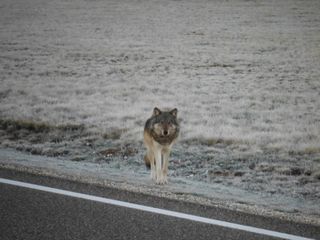Lone Wolf Traveled More Than 450 Miles to Grand Canyon, DNA Confirms

A DNA test has confirmed that a lone gray wolf is roaming Arizona, just north of the Grand Canyon, a long way from its home in the northern Rockies.
The animal, which is protected under the Endangered Species Act, is the first known gray wolf to visit Arizona in about 70 years. The species disappeared from the state in the 1940s, which makes this development exciting news for conservationists who want to see wolves spread back into their former habitats.
After repeated sightings of the wolf over the last month, the U.S. Fish and Wildlife Service (FWS) collected a sample of the animal's feces in Kaibab National Forest, near the north rim of the Grand Canyon. [In Photos: The Fight Over Gray Wolves' Endangered Status]
450-mile journey
The feces sample was sent to the University of Idaho's Laboratory for Ecological, Evolutionary and Conservation Genetics, where a DNA test revealed that the animal is a female gray wolf from the northern Rocky Mountains population. This means the wolf traveled at least 450 miles (725 kilometers) to get to northern Arizona. But such treks are not uncommon for gray wolves, FWS officials said.
"Wolves, particularly young wolves, can be quite nomadic, dispersing great distances across the landscape," Benjamin Tuggle, FWS director for the southwest region, said in a statement Friday (Nov. 21). "Such behavior is not unusual for juveniles as they travel to find food or another mate."
FWS officials were unsuccessful in their attempts to capture the lone wolf so that they could collect a blood sample and remove the inactive radio collar around the animal's neck. Further analysis of the wolf's DNA over the next few weeks could help determine the identity of the wolf, if it had been captured and sampled before on its home turf. The wolf is not related to the small population of Mexican wolves that lives in southern Arizona and New Mexico.
Sign up for the Live Science daily newsletter now
Get the world’s most fascinating discoveries delivered straight to your inbox.
A fraught history and uncertain future
Gray wolves had largely disappeared in the continental United States by the early 20th century because of hunting and predator-eradication campaigns. But then in the 1970s, the animals were among the first species to be granted protections under the Endangered Species Act. Because of the conservation efforts that followed, there are now more than 5,000 gray wolves living across several states, including Michigan, Minnesota, Wisconsin, Idaho, Montana, Wyoming, Oregon and Washington.
Now, gray wolves are no longer considered endangered species in many of those states; in some places, such as Montana, wolf-hunting seasons have been established to help control the species' population. But the creatures still remain on the federal Endangered Species List, so in states like Arizona, gray wolves are still considered endangered. But that could change. Last year, the FWS put forth a controversial plan to take the gray wolf off the federal Endangered Species List. The agency has yet to make a final decision on that proposal.
Some advocacy groups, such as the Defenders of Wildlife and the Center for Biological Diversity, argue that without federal protections, gray wolves would have a hard time recolonizing their former habitats in states like Arizona.
"Because gray wolves are still federally protected in the majority of the continental United States, this wolf was able to safely migrate over 450 miles through states like Colorado to seek out some of her ancestors' most favored habitat," Eva Sargent, director of Southwest programs for the Defenders of Wildlife, said in a statement.
"With patchwork state protection for the species at best, and overt persecution of wolves at worst, journeys like this brave wolf’s would be extremely difficult if not impossible," Sargent added.
Michael Robinson with the Center for Biological Diversity echoed those remarks: "There's so much more room for wolves in the West if only we extend them a bit more tolerance. The Grand Canyon wolf is a prime example of what wolves can do if only we let them."
Follow Megan Gannon on Twitter. Follow us @livescience, Facebook & Google+. Original article on Live Science.

Most Popular

